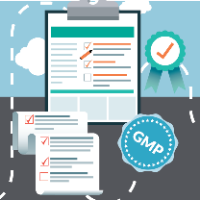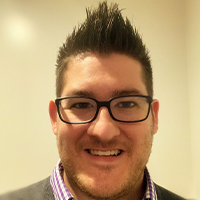Addressing the shortfalls of low reproducibility, low throughput classical analytics for AAV manufacturing
Cell & Gene Therapy Insights 2022; 8(9), 993–997
DOI: 10.18609/cgti.2022.147
What are the key challenges and bottlenecks in AAV vector characterization currently, and why are they coming more to the forefront for the gene therapy industry?
CH: There are a few key challenges that come to mind here. AAVs are significantly more complex than the therapeutics of the past decades, such as monoclonal antibodies and small molecules. The final product is really two products together – a protein capsid, and a ssDNA genome inside carrying the gene of interest. Although there have been advancements in viral vector production, this complexity leads to challenges in scaling to produce sufficient product for analytical method development, product characterization, and to meet market needs. This is part of the reason why we see such high price tags on these gene therapies, but also why there are only a few approved therapies to date. Secondly, during packaging, a variety of capsids are formed including the desired ‘full’ particles, but also both empty and partially filled capsids. These latter populations are undesirable because they decrease the number of therapeutic particles per unit volume and can increase the potential of an adverse immunogenic response. Characterizing the proportion of empty/full capsids is a main challenge in the industry today. Lastly, measuring the potency of the drug product is a key challenge, as most companies currently rely on laborious and highly variable cell-based assays to measure transgene expression.
More and more biopharmaceutical companies are seeing the potential of gene therapy approaches and are now embarking on their own gene therapy programs. The challenges I have mentioned are increasingly at the forefront because of this movement and increased participation from industry, and are the reason why analytical tool providers like Bio-Techne are focused on helping solve these challenges for our customers.
Can you expand on the specific limitations of the ‘traditional’ AAV analytical toolkit that contribute to these issues?
CH: The traditional AAV analytical toolkit contains tools like SDS-PAGE, Western Blotting, ELISA, analytical ultracentrifugation, and TEM. Even though these are established and widely used methods, they all suffer from the same challenges. They have low precision, are not amenable to quality control, and/or lack sufficient throughput. These pitfalls have really driven the analytical tool evolution we have seen in recent years.
What key benefits and advantages do the new generation of analytical tools and techniques, including capillary electrophoresis (CE), provide?
CH: If you think about classical techniques like SDS-PAGE or Western blotting, they are labor-intensive assays with low reproducibility and throughput. Innovative CE platforms like our Maurice and Simple Western instruments replace these old techniques with increased speed, better reproducibility, and ease of use. In addition, these tools have digital outputs and 21 CFR Part 11 compliant software, which enables better data management and data integrity. All of our analytical platforms run on consumables that are produced in an ISO9001 facility, which ensures that high-quality reagents are a part of every run that a user performs.
Turning to Maurice, specifically: what CQAs can it analyze, how, and in what timeframe?
CH: Maurice can run CE-SDS and the industry gold standard imaged cIEF. Together, these modes can cover a wide variety of viral vector CQAs. Specifically, Maurice CE-SDS can be used for rapid purity analysis and identity, including AAV capsid protein ratios. Each analysis takes about 30 minutes of hands-off time, and batches as large as 48 samples can be setup and run automatically. With our new Turbo CE-SDS cartridge, you can get the same data 5x faster which improves throughput and time to answer.
The imaged cIEF (icIEF) mode of Maurice can also be used for AAV identity, empty/full estimation, for formulation screening, and stability testing. In August, we published a platform icIEF denatured AAV method that can differentiate serotypes that are 99% identical. The method is fast, at only 11 minutes per sample, and was also shown to be stability indicating. The icIEF mode can also be used to look at intact AAVs to study empty/full capsid ratio and particle stability. Maurice has two detection channels, absorbance and native fluorescence, that can be used together to measure the DNA content inside the intact capsid. The benefit of this method is that it is rapid at only 10 min per sample, reproducible, and requires small amounts of AAV for analysis. We have done some nice work with Ultragenyx, summarized in an application note last in early 2022, to show this approach for discerning full and empty AAVs.
What are some of the other benefits that Maurice delivers, besides speed of analysis - firstly, in terms of analytical development (AD)?
CH: When you are in AD, having a platform like Maurice is great not just for its speed, but also for its flexibility. That flexibility is exemplified by the types of samples you can analyze, from therapeutic cytokines, mAbs, and fusion proteins to viral vectors like AAVs and Lentivirus. Maurice also affords flexibility by providing multiple modes of operation, dictated by the capillary cartridge being used. As I mentioned earlier, for CE-SDS we have the PLUS and Turbo CE-SDSTM cartridges, which together can cover a user’s workflow essentially from discovery to QC. And while we provide a series of standard methods in our software, we also know that method developers need the ability to easily optimize conditions to get the best results for their samples. For imaged cIEF, Maurice builds upon our gold-standard imaged cIEF, which has absorbance-based detection and added native fluorescence to provide increased sensitivity. This mode is particularly important when analyzing AAVs, lentivirus, and virus-like particles (VLPs), which are formulated at significantly lower protein concentrations than therapeutic mAbs.
And how about in the QC setting? What constitutes being ‘QC-friendly’, and how does Maurice meet these requirements?
CH: There are several aspects of the Maurice platform that make it suitable for product QC and release testing. One of the first that comes to mind is ease of use. We designed Maurice in such a way that any user should be able to get up and running quickly. Our cartridges and consumables are mode-matched, ensuring success when using Maurice for both CE-SDS and icIEF. The next thing is the data – highly consistent both within a run and between runs. This ensures you get the same answer every time when the product has not changed, but allows easy gating of product that has changed. On data integrity, Maurice Compass software is 21 CFR Part 11 compliant, and we also offer Empower® control of Maurice.
To what extent can Maurice help reduce the amount of final vector product required for release testing?
CH: We like to think of Maurice - and frankly, all of our platforms - as sample conservationists. Whether running CE-SDS or icIEF, users do not need to provide much material. Our Maurice methods, specifically, consume just a few microliters of viral vector product and can produce reliable data with as little as 1011 viral particles per milliliter. The excellent reproducibility of these methods and ease of use of the platform also reduce the amount of vector product needed for testing by reducing the need for costly re-tests.
What might be some next steps in analytical tool innovation for the AAV field, driven by the industrializing sector and increasing regulatory stringency?
CH: One of the next steps in analytical tool innovation I think we will see is more platforms becoming capable of analyzing samples close or at the actual manufacturing process. Specifically, process analytical tools (PAT) that can be used either in-line or at-line to monitor, for example, viral vector aggregation analysis will be needed. To meet these needs, analytical tools need to be faster and ideally, able to be integrated to participate in feedback loops to alter production conditions in order to maintain certain product qualities. Another common trend I see is the desire for more multi-attribute methods, where one platform provides more than one answer. As we’ve been discussing, Maurice is a single platform capable of addressing multiple CQAs. At Bio-Techne, we are keenly focused on the needs of our clients and will continue to provide innovative solutions for C> researchers and manufacturers.
Affiliation
Chris Heger, PhD
Director of Applications Science
Analytical Solutions Division
Bio-Techne
Authorship & Conflict of Interest
Contributions: All named authors take responsibility for the integrity of the work as a whole, and have given their approval for this version to be published.
Acknowledgements: None.
Disclosure and potential conflicts of interest: Chris Heger is an employee of, and owns stock in Bio-Techne. Bio-Techne has paid for CH travel to conferences. CH has several patents in progress, at various stages. The author has no other conflicts of interest to disclose
Funding declaration: The authors received no financial support for the research, authorship and/or publication of this article.
Article & copyright information
Copyright: Published by Cell and Gene Therapy Insights under Creative Commons License Deed CC BY NC ND 4.0 which allows anyone to copy, distribute, and transmit the article provided it is properly attributed in the manner specified below. No commercial use without permission.
Attribution: Copyright © 2022 Bio-Techne. Published by Cell and Gene Therapy Insights under Creative Commons License Deed CC BY NC ND 4.0.
Article source: This article is based on an interview with Chris Heger.
Revised manuscript received: Aug 29 2022; Publication date: Sep 24 2022.


